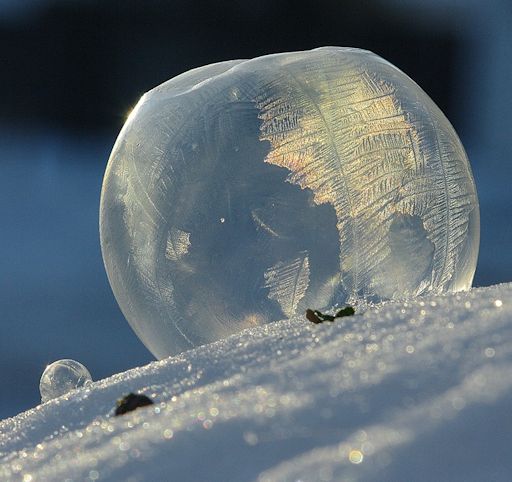DECREASING CHANCE OF FLARES: NOAA forecasters have downgraded the chance of X-flares on Jan. 14th to 15% as giant sunspot AR1944 rotates off the solar disk. The odds on Jan. 15th are even lower: 1%. A spell of quiet appears to be in the offing. Solar flare alerts: text, voice.
FROZEN BUBBLES: Science teacher Tom Wagner of Waterloo, Iowa, is an avid photographer of snowflakes. Over the years he has discovered a great way to catch large flakes in mid-air: "I blow a soap bubble and allow the snowflake to land on it," he explains. Once the snowflake is properly corralled, the photography is relatively easy.
Last week when the Polar Vortex descended over Iowa, Wagner went outdoors to capture some more snowflakes. Just one problem: It was so cold outside, the soap bubbles themselves froze:
"I made a decision to photograph these frozen bubbles on the snow," says Wagner. "The sun was 20 minutes from setting so I had to act fast. Most of the bubbles popped when they landed but with some practice I discovered a technique that resulted in quite a few remaining intact."
"After a few pictures at home I hurried over to a nearby cemetery where there was still several more minutes of direct sunlight. The men digging nearby must have wondered what I was doing blowing little bubbles onto the snow then lying next to them with my camera in hand. Having the sun in the immediate background illuminated the fern-like crystals growing within the curved bubble skin."
More of Wagner's cold weather photography may be found on his Facebook page.
Realtime Space Weather Photo Gallery
JUPITER AND THE MOON: When the sun goes down tonight, step outside and look east. The waxing full Moon is having a close encounter with Jupiter. Stojan Stojanovski sends this picture of the meeting from Velmej-Ohrid, Macedonia:
In Stojanovski's photo, the Moon has circumscribed Jupiter inside a luminous ring. It's a 22o halo, caused by ice crystals in high cirrus clouds. Lunar ice halos are most often seen when the Moon is high and bright. With Jupiter so close to the bulls-eye, tonight is a great time to look!

Solar wind
speed: 617.0 km/sec
density: 1.8 protons/cm3
explanation | more data
Updated: Today at 1607 UT
X-ray Solar Flares
6-hr max: C1 1231 UT Jan14
24-hr: C2 0327 UT Jan14
explanation | more data
Updated: Today at: 1600 UT
![]()
Daily Sun: 14 Jan 14
Decaying and departing, sunspot AR1944 has a 'beta-gamma' magnetic field that harbors energy for M-class solar flares. Credit: SDO/HMI
![]()
Sunspot number: 102
What is the sunspot number?
Updated 14 Jan 2014
Spotless Days
Current Stretch: 0 days
2014 total: 0 days (0%)
2013 total: 0 days (0%)
2012 total: 0 days (0%)
2011 total: 2 days (<1%)
2010 total: 51 days (14%)
2009 total: 260 days (71%)
Update 14 Jan 2014
The Radio Sun
10.7 cm flux: 143 sfu
explanation | more data
Updated 14 Jan 2014
![]()
Current Auroral Oval:
Switch to: Europe, USA, New Zealand, Antarctica
Credit: NOAA/POES
![]()
Planetary K-index
Now: Kp= 3 quiet
24-hr max: Kp= 4 unsettled
explanation | more data
Interplanetary Mag. Field
Btotal: 3.6 nT
Bz: 0.2 nT north
explanation | more data
Updated: Today at 1607 UT
![]()
Coronal Holes: 13 Jan 14
Earth is inside a stream of solar wind flowing from the indicated coronal hole. Credit: SDO/AIA.






